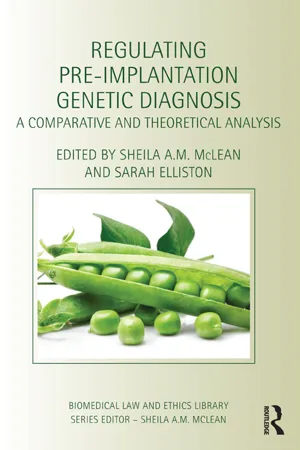
Regulating Pre-Implantation Genetic Diagnosis
A Comparative and Theoretical Analysis
- 264 pages
- English
- ePUB (mobile friendly)
- Available on iOS & Android
Regulating Pre-Implantation Genetic Diagnosis
A Comparative and Theoretical Analysis
About this book
The successful achievement of pregnancies following pre-implantation genetic diagnosis (PGD) was first reported in April 1990. The technology is often used for patients who are at substantial risk of conceiving a pregnancy affected by a known genetic disorder, however from this technology other more controversial uses have arisen such as HLA typing to save the life of a sibling, gender selection for social reasons, the prevention of late onset diseases, or the prevention of diseases which may be genetically predisposed to developing such as breast cancer. The technology surrounding PGD is constantly developing, giving rise to new and unexpected consequences that create fresh ethical and legal dilemmas.
Featuring internationally recognized experts in the field, this book critically explores the regulation of PGD and the broader legal and ethical issues associated with it. It looks at the regulatory situation in a number of jurisdictions including New Zealand, Australia and the United Kingdom, but it also explores a number of themes of wide significance including a historical consideration of PGD and its part in the creation of the "genetic embryo" as a political tool, the over regulation of PGD and the ethical difficulties in handling additional unexpected medical information yielded by new technologies. This book will be of particular interest to academics and students of law, medicine and ethics.
Frequently asked questions
- Essential is ideal for learners and professionals who enjoy exploring a wide range of subjects. Access the Essential Library with 800,000+ trusted titles and best-sellers across business, personal growth, and the humanities. Includes unlimited reading time and Standard Read Aloud voice.
- Complete: Perfect for advanced learners and researchers needing full, unrestricted access. Unlock 1.4M+ books across hundreds of subjects, including academic and specialized titles. The Complete Plan also includes advanced features like Premium Read Aloud and Research Assistant.
Please note we cannot support devices running on iOS 13 and Android 7 or earlier. Learn more about using the app.
Information
Table of contents
- Cover
- Halftitle
- Title
- Copyright
- Contents
- Notes on contributors
- Introduction
- 1 Pre-implantation genetic diagnosis: safely born but not designed
- 2 The weak moral basis for strong PGD regulation
- 3 PGD and the making of the ‘genetic embryo’ as a political tool
- 4 Statutory regulation of PGD in the UK: unintended consequences and future challenges
- 5 The welfare of the child principle and the use of PGD: selecting for disability
- 6 Regulating abortion and pre-implantation genetic diagnosis in the Australian states of New South Wales, Victoria and Western Australia: comparing and contrasting regulative approaches
- 7 Regulatory legitimacy: the case for controlling and restricting access to PGD for sex-selection purposes
- 8 Cartwright calamities, Frankenstein monsters and the regulation of PGD in New Zealand
- 9 The state in action: an insider’s view of how the state regulates the use of PGD with HLA tissue-typing in New Zealand
- Conclusion
- Index